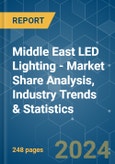The Middle East LED Lighting Market size is estimated at USD 4.01 billion in 2024, and is expected to reach USD 5.94 billion by 2029, growing at a CAGR of 8.17% during the forecast period (2024-2029).
The rising demand for LED products due to various supportive government regulations and increasing commercial construction projects, including cinemas and shopping malls, are driving the demand for LED lighting products in the region.
This product will be delivered within 2 business days.
The rising demand for LED products due to various supportive government regulations and increasing commercial construction projects, including cinemas and shopping malls, are driving the demand for LED lighting products in the region.
Key Highlights
- According to Phillips Lighting, one of the leading providers of LED lighting solutions, about 22% of the electricity used in the Middle East is spent on lighting. The increasing awareness about using energy-efficient lighting solutions is driving the demand for LED lighting in Middle Eastern countries.
- For instance, in May 2021, a comprehensive awareness campaign was launched on Abu Dhabi Island to demonstrate the positive environmental benefits of replacing traditional lighting with energy-saving LED streetlights by Abu Dhabi Municipality (ADM) under Abu Dhabi's Department of Municipalities and Transport through its infrastructure and municipality assets sector.
- Furthermore, the growing construction activities in the public and commercial sectors in the region also support the growth of the studied market. For instance, in September 2021, Oman's Special Economic Authority of DUQM awarded a project worth USD 61 million for constructing Dual Carriageway Road for NR 32 Phase 2 at Duqm.
- However, factors such as higher installation costs and low awareness among the region's developing countries are challenging the growth of the studied market.
- Moderate impact of COVID-19 was observed in the middle eastern countries. However, the commercial and industrial sector was impacted significantly due to disruption in the supply chain, as countries such as China, India, and the United States, who are among the largest exporters to the Middle Easter countries, were severely impacted by the pandemic.
Middle East LED Lighting Market Trends
Increasing Construction Activities to Drive the Demand for LED Lightings
- According to GE Current, LED lights use about 50 percent less electricity than traditional fluorescent, incandescent, and halogen options. For spaces with lights that are on for extended periods, such as commercial buildings, offices, etc., having such features help in substantial energy cost saving.
- The commercial buildings across the Middle Eastern region, especially in Saudi Arabia, UAE, and Qatar, have increased significantly in the last few decades. For instance, the Saudi Arabian construction market continues to witness significant growth and offers lucrative potential due to several initiatives taken by the Saudi government, such as Vision 2030, NTP 2020, and several other reforms to diversify the country's economy away from oil.
- In January 2022, the Saudi Arabian government signed an agreement to develop the largest mall in Makkah, which also involves Umm Al-Qura and Hamat Holding. The project is expected to have an investment volume of SR 2.7 billion, with the work set to be completed by 2026.
Saudi Arabia to Hold Significant Market Share
- Saudi Arabia is among one of the largest markets in the Middle East region. For instance, according to OPEC, Saudi Arabia is the 14th largest country in the world and the second-largest OPEC Member Country. Over the years, the country has witnessed significant growth in infrastructure development, creating a favorable market scenario for the growth of the studied market.
- For instance, according to ITU, Saudi Arabia is currently building 16 smart cities (including Red Sea, NEOM, Qiddiya, SPARK, and Waad Alshamal) to achieve its aim to become the most connected and digitized nation by 2030. This is expected to offer significant opportunities for the growth of the LED lighting market during the forecast period.
- Furthermore, the increasing awareness about using energy-efficient products also encourages companies to replace traditional lighting systems with LEDs. For instance, in April 2021, the National Energy Efficiency Services Company (NESCO) announced that it would replace 74,000 traditional 'sodium' lamps with other smart systems (LED) lights in 8 municipalities of the Riyadh region.
Middle East LED Lighting Industry Overview
The Middle East LED Lighting Market is growing in completion, as the increasing demand for LED lighting attracts new players. To fulfill the growing demand and expand their presence, the vendors focus on developing new products, partnerships, and acquisitions. Some major players operating in the market include Apple Lighting Co., Rikada LED, RR Global, and National Lighting Company.- April 2022 - Oman Aquarium of Mall of Muscat became the largest Middle Eastern Aquarium lighted by Orphek LED Lighting Solutions. The aquarium's construction work was completed under AAT's expertise, and Orphek Solutions did the lighting.
- July 2021 - Iran's Industrial Development and Renovation Organization entered into a joint venture with a foreign company to produce explosion-proof LED lamps in Shiraz Special Economic Zone. During the project, different types of explosion-proof LED lamps from 30 watts to 200 watts will be produced.
Additional Benefits:
- The market estimate (ME) sheet in Excel format
- 3 months of analyst support
This product will be delivered within 2 business days.
Table of Contents
1 INTRODUCTION
4 MARKET INSIGHTS
5 MARKET DYNAMICS
6 MARKET SEGMENTATION
7 COMPETITIVE LANDSCAPE
Companies Mentioned (Partial List)
A selection of companies mentioned in this report includes, but is not limited to:
- OPPLE Lighting Co
- Rikada LED
- RR Global
- JAF Lights & Electricals
- National Lighting Company
- Nakashi LED
- DCD Technologies
- Iran Light Co.
- Majees Lighting Industries LLC
- CESP LED
- Lumega Group
- Global Light & Power LLC
Methodology

LOADING...










